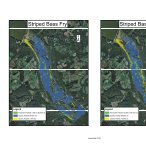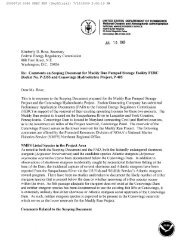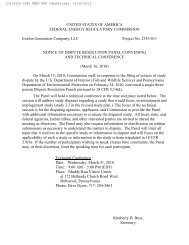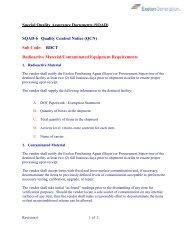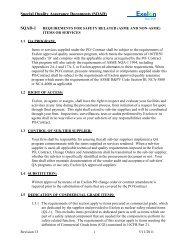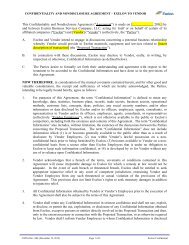Final Report Historical Structures Assessment Report for the Muddy ...
Final Report Historical Structures Assessment Report for the Muddy ...
Final Report Historical Structures Assessment Report for the Muddy ...
You also want an ePaper? Increase the reach of your titles
YUMPU automatically turns print PDFs into web optimized ePapers that Google loves.
Historic <strong>Structures</strong> <strong>Assessment</strong> <strong>Report</strong> <strong>for</strong> <strong>the</strong> <strong>Muddy</strong> Run Pumped Storage Facility Project Relicensing Application<br />
Lancaster and York Counties, Pennsylvania<br />
Perryville after 1866. Upon completion, <strong>the</strong> Columbia & Port Deposit Railroad was operated as a branch<br />
line of <strong>the</strong> Pennsylvania Railroad.<br />
With <strong>the</strong> advent of <strong>the</strong> railroad, <strong>the</strong> counties within <strong>the</strong> project area began to change rapidly. Abundant<br />
natural resources allowed <strong>the</strong> area to continue to grow and prosper. Fisheries, agricultural products, large<br />
<strong>for</strong>ested areas, and Cecil and York Counties’ rich wealth of mineral resources, such as chrome, granite,<br />
magnesium, and iron ore placed <strong>the</strong> Lower Susquehanna Region at <strong>the</strong> heart of America's early<br />
manufacturing and extractive industries.<br />
Statistics indicate <strong>the</strong> importance of milling throughout <strong>the</strong> region, primarily in <strong>the</strong> mid-nineteenth<br />
century, when in Martic Township <strong>the</strong>re were 12 mills in 1840. By 1860, <strong>the</strong> number had dropped to three<br />
mills and five saw mills. In Drumore Township, milling was most important in <strong>the</strong> 1840s and 1860s,<br />
when <strong>the</strong>re were six mills and nine sawmills in 1848, and five mills and eight sawmills in 1860 (Bridgens<br />
1864 and Everts & Stewart 1875). Lastly, in Lower Chance<strong>for</strong>d Township, <strong>the</strong> mid-nineteenth century<br />
had seven mills and seven sawmills in 1848, and only eight mills in 1860 (Nichols 1876 and Roddy<br />
1916).<br />
The commercial Susquehanna fishing industry got its start during <strong>the</strong> eighteenth century. Shad fisheries<br />
remained an important part of <strong>the</strong> local economy until <strong>the</strong> late nineteenth century. There was a shad<br />
fishery noted on <strong>the</strong> western shore of Mount Johnson Island in 1886. Fishermen also caught eels, herring,<br />
perch, salmon, and carp (Gibson 1886:764; Miller 1949:125; Sarudy 2001:71).<br />
As transportation facilities improved during <strong>the</strong> nineteenth century—in <strong>the</strong> <strong>for</strong>m of canals and railroads—<br />
numerous industries were able to flourish in <strong>the</strong> Lower Susquehanna Valley, including tanbark mills,<br />
paper mills, fulling mills, sawmills, flint mills, lime kilns, canneries, creameries, and ice harvesting<br />
(Sarudy 2001:104–105). Mining and quarrying became <strong>the</strong> economic mainstays of Peach Bottom<br />
Township. Although abandoned by 1895, chrome mining at Rock Spring and Epsom salt mining had been<br />
notable industries in <strong>the</strong> township.<br />
Slate Point, a short distance below Peach Bottom Ferry, is <strong>the</strong> eastern terminus in York County of a<br />
valuable vein of slate that extends through Peach Bottom Township into Har<strong>for</strong>d County, Maryland . The<br />
slate ridge continues across <strong>the</strong> Susquehanna River to Fairmount, in Little Britain Township, Lancaster<br />
County. A valuable slate quarry was operated near Slate Point circa 1861 (Gibson 1886:764).<br />
Peach Bottom slate, used as a roofing material since 1734, was known <strong>for</strong> its strength, color, toughness,<br />
and durability. Commercial quarrying of Peach Bottom slate began in 1785. It was used <strong>for</strong> roofs,<br />
foundations, tombstones, and <strong>for</strong> industrial building material. After Peach Bottom slate was exhibited at<br />
<strong>the</strong> London Crystal Palace Exposition of 1850 and received first prize, it was in demand all over <strong>the</strong><br />
world. More uses were adopted <strong>for</strong> slate when it was granulated or pulverized. It was used as fertilizer<br />
and in syn<strong>the</strong>tic roofing; it became an additive in paint, linoleum, and rubber (Morrow [1953]:26, 28).<br />
Welsh immigrants were attracted to <strong>the</strong> area because <strong>the</strong> slate was so similar to that which <strong>the</strong>y had<br />
quarried in Wales; <strong>the</strong>y built homes in a style similar to those in <strong>the</strong> slate regions <strong>the</strong>y came from (Sheets<br />
1991:124). At <strong>the</strong> time, both <strong>the</strong> Maryland & Pennsylvania and <strong>the</strong> Baltimore & Delta Railroads served<br />
<strong>the</strong> Peach Bottom area. Due to <strong>the</strong> railroad depots at Peach Bottom, it became a shipping center and<br />
consequently, warehouses, coal yards, hotels, and mills were built <strong>the</strong>re (Smeltzer 1963:54).<br />
13





